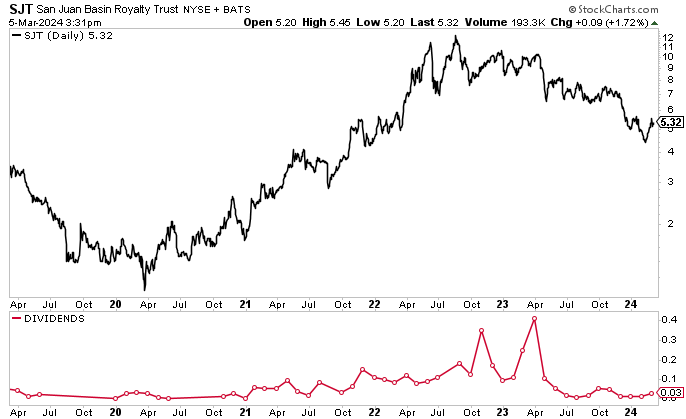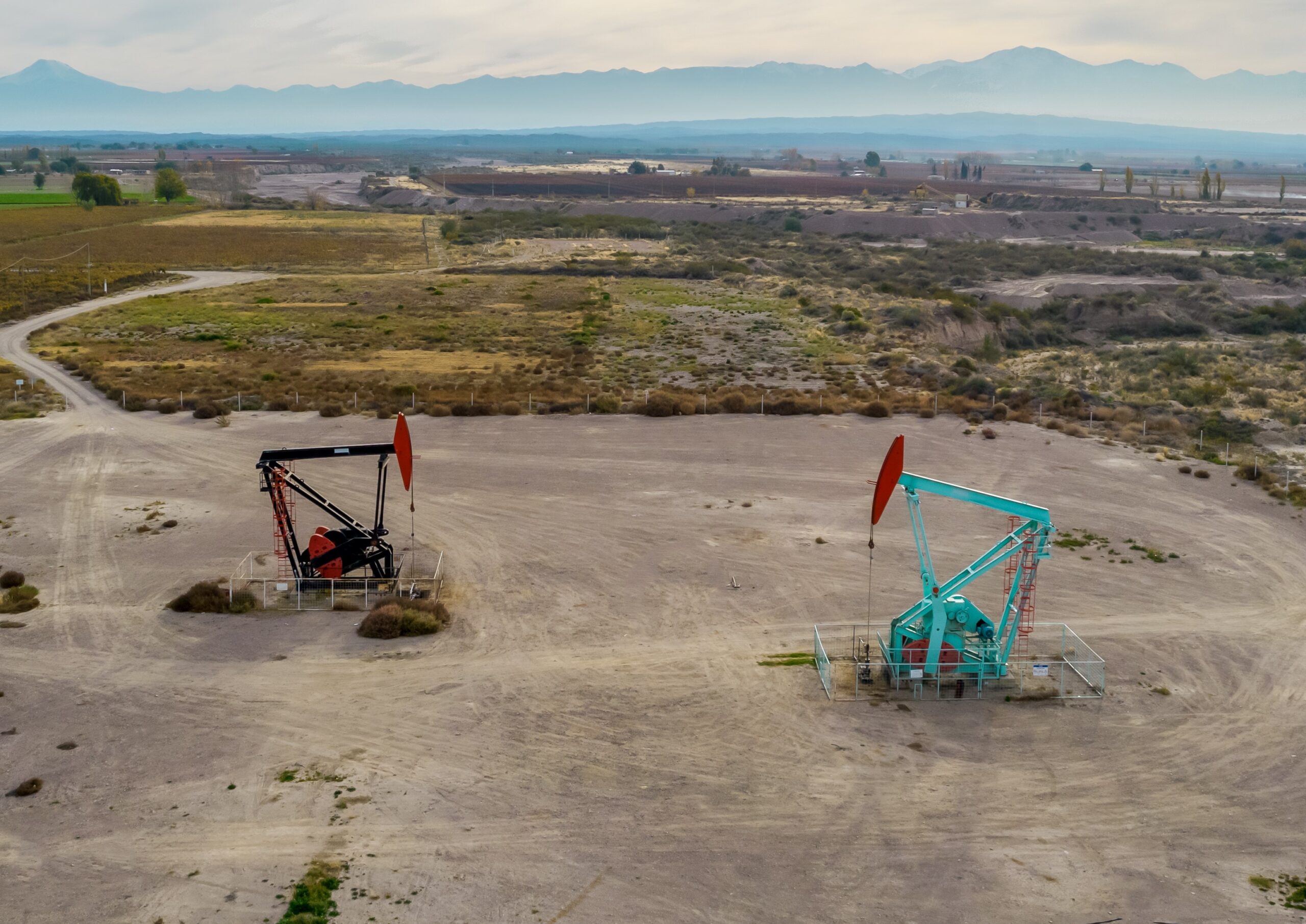Outlook for 16%-Yield San Juan Basin Royalty Stock Is Robust

SJT Stock Pays Monthly Dividends
What a difference a couple of years can make. Oil prices are down from their March 2022 high of $130.00 per barrel, hovering around $79.00 per barrel.
Despite the 40% drop and projections by some analysts that oil prices would remain under pressure, the opposite has been happening. West Texas Intermediate (WTI) crude oil is up by almost 10% in 2024, rising for a second consecutive month in February.
Admittedly, oil stocks can be volatile. They were the biggest winners in 2022, and they also did well in 2023. So far, 2024 hasn’t been as good for oil stocks; not many of the biggest energy stocks have been outperforming the market in 2024.
There are, however, some smaller players that have been providing solid gains. Shares of San Juan Basin Royalty Trust (NYSE:SJT) are up by a respectable 7.5% year-to-date (as of this writing), and the company recently hiked its monthly dividend by about 86%.
With the Organization of the Petroleum Exporting Countries Plus (OPEC+) extending its voluntary oil production cut of 2.2 million barrels per day until the middle of 2024, many think oil prices could retrace from their current level to about $76.50 per barrel. But oil prices could surprise to the upside this year.
On one hand, the recent attacks on ships in the Red Sea haven’t affected oil shipments yet, due to vessels taking alternate routes. Furthermore, spare capacity from OPEC+ and muted demand for energy have helped prevent oil prices from spiking.
On the other hand, the U.S. economy remains resilient and central banks have helped many of the biggest economies avoid a recession.
About San Juan Basin Royalty Trust
San Juan Basin Royalty is a royalty trust with a 75% net overriding royalty interest in the San Juan Basin of New Mexico. Most of the company’s subject interests are owned and operated by Hilcorp San Juan LP. (Source: “About Us,” San Juan Basin Royalty Trust, last accessed March 5, 2024.)
Virtually every penny that comes from the company’s oil and gas leaseholds goes directly to its unitholders as monthly dividends. Rising oil prices and high demand should help juice its monthly payouts.
Unlike actively managed trusts, in which a management team can grow its assets, San Juan Basin Royalty Trust doesn’t engage in any new business or commercial activity, nor can it use any portion of the trust to acquire additional properties. What this means is that the company’s assets (oil wells) will eventually run dry.
But that won’t happen for quite some time. The trust has enough energy reserves to run for at least another 10 to 15 years—probably more. The number of years could increase as drilling technology improves.
In February, Hilcorp San Juan LP announced its 2024 plan, estimating its capital expenditures for the year at $36.0 million. (Source: “San Juan Basin Royalty Trust Announces February Cash Distribution and Hilcorp’s 2024 Capital Plan,” San Juan Basin Royalty Trust, February 16, 2024.)
Of that, about $27.0 million is allocated for three new drilling projects, about $8.0 million is allocated for recompletions and workovers of 36 projects, and about $1.0 million is allocated for other projects, including some related to natural gas compression.
Distribution Jumped 86% Month-Over-Month
In February, San Juan Basin Royalty announced a monthly cash dividend of $1.41 million, or $0.030258 per unit, to be paid on March 14. (Source: “Cash Distributions,” San Juan Basin Royalty Trust, last accessed March 5, 2024.)
That translates to a yield of 16.3% (as of this writing).
Moreover, the distribution that the company declared in February was up by 85.98% from the distribution it declared in January of $758,308, or $0.01627 per unit.
In December 2023, San Juan Basin Royalty Trust’s natural gas volumes for the subject interest totaled 1,909,007 thousand cubic feet (Mcf), compared to 1,877,464 Mcf in November 2023. (Source: “San Juan Basin Royalty Trust Announces February Cash Distribution and Hilcorp’s 2024 Capital Plan,” San Juan Basin Royalty Trust, February 16, 2024.)
Dividing the company’s gas revenues by its production volume results in an average gas price of $2.99 per Mcf for December 2023, versus $2.96 for November 2023.
As you can see in the following table, San Juan Basin Royalty stock’s annualized payouts more than doubled from 2021 to 2022 after cratering in 2020 during the COVID-19 pandemic. The annualized distributions can sometimes be quite high; they hit $3.06 per unit in 2008.
| Year | Distribution Per Unit |
| 2023 | $1.10 |
| 2022 | $1.66 |
| 2021 | $0.77 |
| 2020 | $0.15 |
| 2019 | $0.17 |
| 2018 | $0.35 |
| 2017 | $0.83 |
| 2016 | $0.29 |
| 2015 | $0.36 |
| 2014 | $1.28 |
(Source: “Cash Distributions,” San Juan Basin Royalty Trust, op. cit.)
What this means is that investors need to pay attention to what’s going on in the energy sector. SJT stock isn’t the kind of investment you can just buy and forget about.
You can see in the chart below (the circles on the red line) that San Juan Basin suspended its dividends for four months in 2020.
Moreover, San Juan Basin stock’s share price can make big moves to the upside and downside, closely following the gyrations of WTI oil prices.
Between March 2020 and August 2022, SJT stock rallied by 392%. Since August 2022, SJT units have fallen by 48% (as of this writing). They have, however—as noted above—rallied by 7.5% in 2024, just like the price of WTI oil has.

Chart courtesy of StockCharts.com
The Lowdown on San Juan Basin Royalty Trust
No stock is perfect, but under the right conditions, San Juan Basin Royalty stock can be an excellent oil and gas play that provides investors with long-term capital appreciation and ultra-high-yield monthly distributions.
The price of SJT units hasn’t fared all that well over the last year, but that should change once inflation is reliably in the Federal Reserve’s target range, interest rates decline, and the economy moderates. That’s a lot to ask for, but it’s a certainty.
Until then, industry tailwinds have been helping San Juan Basin Royalty Trust report solid monthly financial results and provide investors with reliable monthly dividends.











